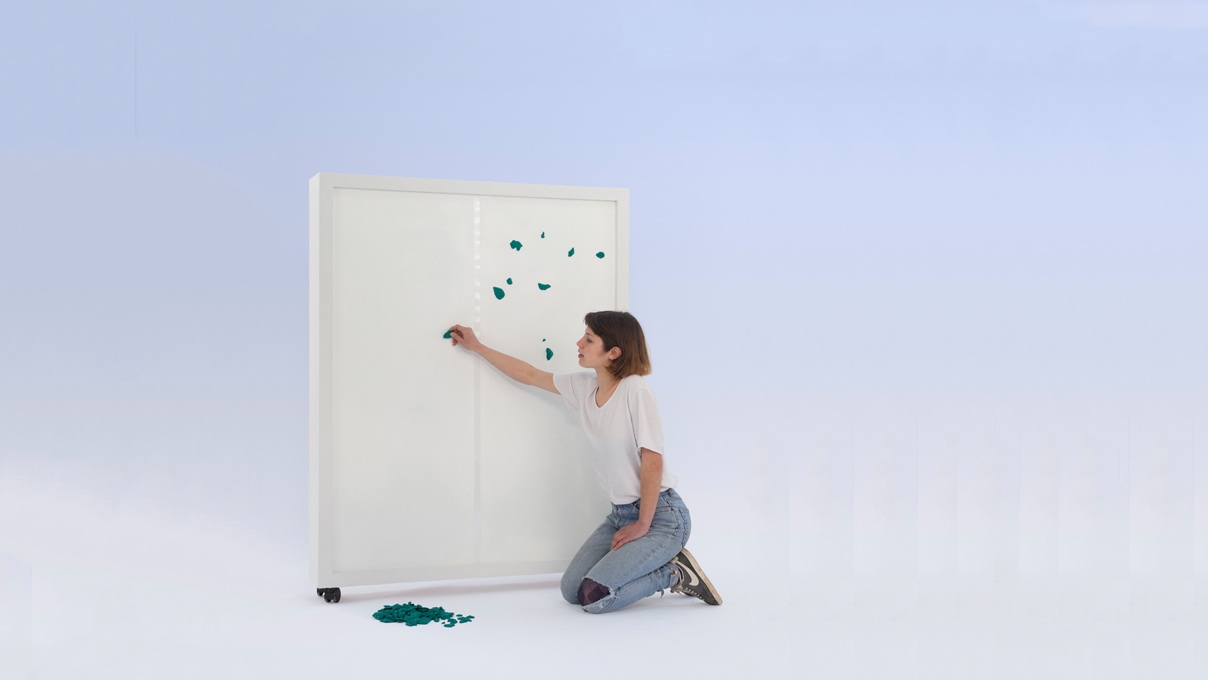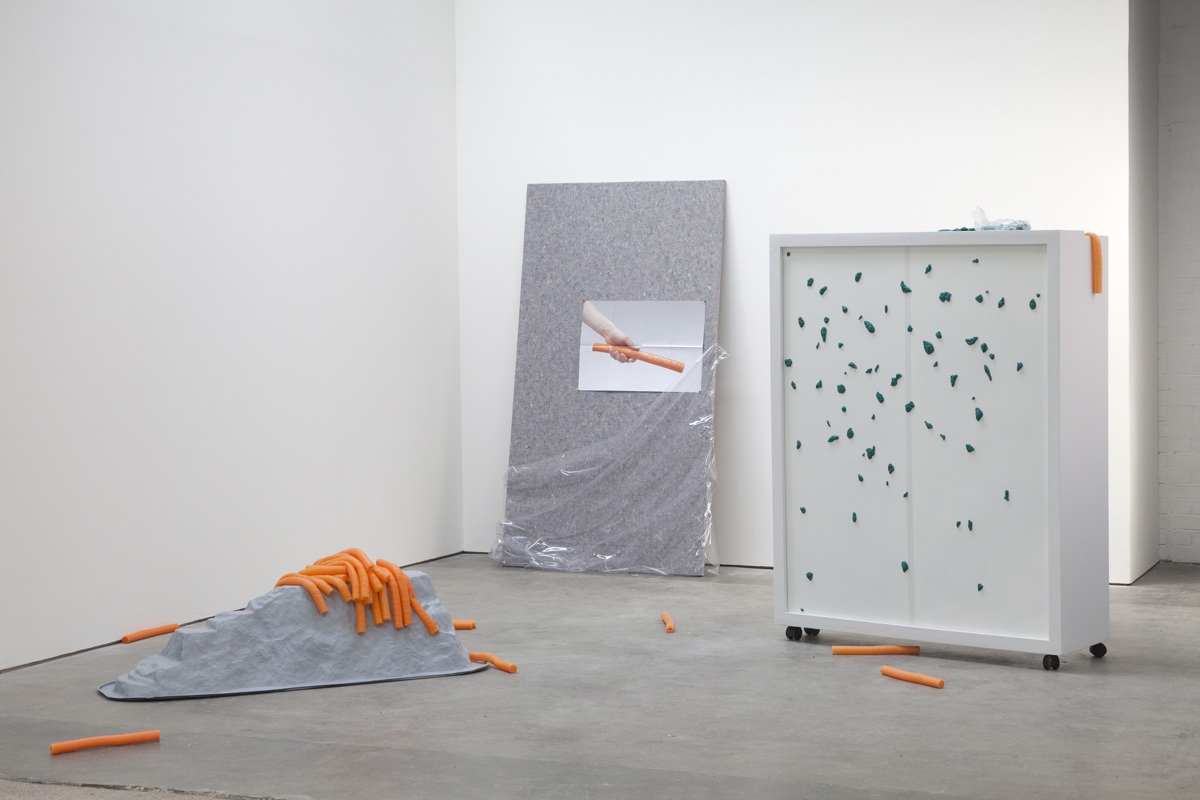Sebastian Jefford
Interview by David McLeavy
Published October 2013
-
Sebastian Jefford works in painting, sculpture, photography and digital platforms and has exhibited work in both Britain, Germany and USA. Amongst other things his work deals with visual perceptions of groups of objects, that in many cases are staged by him.
-
One thing that intrigues me about your work is your use of titling, and how that title may have a direct suggestion onto what you are trying to achieve with the work. I sight examples such as If a stone has an ugly-looking top you should place it so as to give prominence to its better side. Even if this means it has to lean at a considerable angle, no one will notice, 2013, from your recent solo show at Works|Projects. How do you set about titling your work and how important are the titles to the work itself?
Titling for me is pretty important, as it’ll often frame a piece of work in terms of ideas I’m interested in (in a roundabout way), but also they frame a piece within an assemblage of others. The titles are often attributes or instructional phrases that are borrowed, usually from catalogues, descriptions or manuals of the material or thing itself, or sometimes phrases I’ve come up with, but either way they usually hint at some kind of absurd utility or ambiguous activity that is physically there in the object itself and as a nod to the wider scope of ideas I’m interested in. Sometimes there are specific references in there, which are really important for me and are there as a way in, but I try to pick titles that operate on a few levels, as I don’t want my work to rely on the viewer having to ‘get it’, and equally as much I like the idea that the work operates on its own terms. I suppose the titles suggest a climate that the object might inhabit, so they’re important in creating a world or situation around a thing or set of things.
That title you mentioned is taken from ‘Sakuteiki’, which is the oldest known manual for making Japanese rock gardens, its around a thousand years old. Japanese rock gardens are constructed to be viewed from a designated seating area outside the garden itself, so they almost function as images in this sense, or at least image-like. There’s this idea of a very physical process, lots of lifting big boulders and raking, that’s intended output is a very flat form of encounter, almost as a kind of idealised, elegant, tranquil image. That title hints to an idea of a kind of idealized surface encounter of an object, and that if this designated position is deviated from there is a potential for awkwardness, disappointment, sniggering, the flop of a tableau or the revealing of a farce, which is how I want my work to operate.

Borrowed Scenery, 2013
There is an interesting comparison to the way a Japanese rock garden is constructed in order for the viewer to see one angle of the garden along with the way that an installation photograph of an exhibition may dictate the optimum viewing perspective. Was this something that you had in your mind when it came to documenting your show at Works|Projects, or similarly how you document any of your work?
Absolutely, although I think the comparison is broader than that, and might apply to just about anything we look at as an image. The way ‘Records of Garden Keeping’ was documented was really important; I wanted the documentation to be part of the work in its own right and offer its own kind of flat, staid experience. Basically, while the show was on, all that was available to view on the website was individual images of the objects, shown as a kind of slideshow GIF, or in stills. The objects were photographed against neutral backgrounds, removed from any kind of recognisable location, in an ambiguous kind of non-space, as an acknowledgment of their place in the virtual. In the gallery itself, the objects appeared to have been used in some kind of activity or performance, they suggested a sense of being interchangeable, a plasticity. But they also revealed their own shoddy facades and raw backsides, and in doing so became these kind of pathetic, superficial, flaccid objects. So there was a discrepancy between the images shown online / on the flat screen and in the gallery but at the same time they both offered this very flat, surface experience, a kind of skin. Immersion in flatness. The objects in the gallery became props to an unknown performance or activity – but one that never happened. This is where I really want to try and push the work, I want to make these spaces that allude to this kind of activity – a kind of repetitive, dumb activity that offers no resolve, no end product. An idea of fictionalized activity.
The aim was to have it so that if one person went to see the works in the gallery and one person viewed the works on the website both would see different things, would come away with a different kind of experience, or if you saw both, there was a narrative to grab onto. But it was also about giving the documentation actual agency, to offer or build up a different, rather than secondary, kind of encounter. I suppose as a way to try and extend the work beyond the exhibition, and enter into a more liminal space – here, there and everywhere, now and then, all at once.

After 40 seconds have elapsed, say Stop! (video still), 2013
To move onto a slightly different area of your work, it seems like you have spent a great deal of time and effort in creating very tactile objects that entice the viewer to interact with them. How important is the tension that’s created by placing tactile artworks into a space that historically doesn’t allow for physical interaction, and/or is physical interaction with your work something you would like to encourage/explore?
For me its about trying to create a whole environment that is extremely haptic or tactile; or rather to go further than tactile, to address the body as a whole, the whole receptacle, but in a very artificial, flat, almost diluted way. I suppose a simpler way of putting it would be to say I’m trying to immerse the viewer in secondary experiences
or representations.
But the tactile nature of the work is key in setting up its own failure, or its pathetic character. This allusion to physical and tactile interaction is often deliberately comprised by the objects’ own crappy, spurious façades and surface treatments, their complete lack of function, but also as a way of drawing attention to the ‘barrier’ of an image or a screen when they’re inevitably documented. A pile of orange, sagging batons piled on top of a ‘boulder’ appear flexible, but on closer inspection reveal themselves to be stiff, hardened and unmovable. So its about creating this veneer of tactility if you like.
This idea of exploring physical interaction as a kind of taboo or something within the historically-charged context of a gallery is less interesting to me. Maybe less the idea of actual physical interaction with the work and more the enticing, suggestion or potential, or expectation and disappointment. Some of the work does literally have the potential to be reconfigured, and the idea that the object/image is potentially subject to change by a rogue viewer is exciting though – that sense of temporality is really important.
As I mentioned previously, your work seems to be very well produced and finished. Do you make the work yourself or do you get it fabricated elsewhere? And to follow on from that, how important is it that you do/don’t fabricate the items yourself?
You're too kind... That is a really important thing for me though, which I'm sure has become clear over the course of this conversation - it very much has a slickness to it when viewed from a distance or in documentation, but up close or if you just walk around the back of some pieces, they reveal a very handmade and sometimes raw quality, or even a complete bodge (of which I am an absolute advocate). So far I have made pretty much everything myself, apart from the readymade parts, (e.g. the artificial rock), digital prints and a bit of help from a professional photographer. This is important for me, but not for any other reason other than the fact that I really, really enjoy making it all myself. However time is often an issue and having the less fiddly stuff fabricated would make life easier at times...

Records of Garden Keeping, Works|Projects, 2013
So you studied Art and Visual Culture at The University of the West of England. Could you talk a little about the course, how it may be different to the traditional Fine Art course and how you feel it has influenced your current work?
For the most part it was much like any other Fine Art course - it was studio-based, and very much practice-led, but we had to write a text that was somehow entwined with what we were doing, (separate from the dissertation). It pretty open ended - we were free to choose whether or not we wanted it to function as a work in itself or
as something that sat alongside our practices. Thats not to say it was a complete free-for-all, we were encouraged to write something that made sense with what we were doing. So if writing a really academic, research based text made sense within your practice, then you'd do that, but if writing a play made sense you could do that. It was a good way to consolidate research or ideas that weren't necessarily that apparent from looking at whatever I was making, to flesh them out into something coherent, rather than leaving it all stew into a pottage in my head. It also meant that it was particularly ideas-led, which seemed really valuable.
I'm not really that sure how its influenced current work. I read and research but I think that is something I would do and think is important anyway. I also do a bit of writing every now and then, but not really anything I'd show at the moment... The tutors and friends on that course were more influential than the structure of the course itself I think.
So finally whats next for you?
Menna Cominetti, James Parkinson and I are busy working on a project called 'Dumb Shadow' that is going to be at Supercollider in Blackpool in November, which I'm really excited about. Apart from that, just to keep going.
-
Sebastian Jefford lives and works in Bristol. Recent exhibitions include Performance Fetish, SWG3 Gallery, Glasgow, Surface Area, Favorite Goods, Los Angeles and Records of garden keeping, Works|Projects, Bristol.
-
If you like this why not read our interview with Lauren Godfrey
-
© 2013 - 2018 YAC | Young Artists in Conversation ALL RIGHTS RESERVED